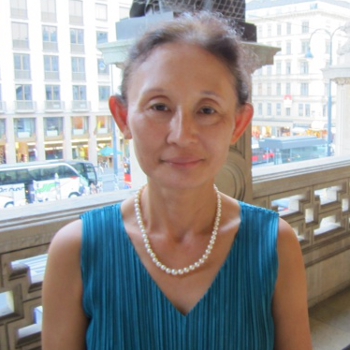Lady Macbeth of Mtsensk is a complex opera of four acts over nine scenes, with Shostakovich’s signature style of dissonant and syncopated music mixed with more accessible melodies. Some of the more distinct music, often played by woodwinds and brass, is tinged with irony, humor and menace. There are elements of Viennese waltz, not to mention traditional Russian folk melodies. A series of orchestral interludes connect the scenes; they serve as a vehicle for background story as well as emotional expressions of protagonists. The score calls for a large orchestra, with brass and percussion prominent. Frequent shifts in musical style are disorienting and unfamiliar. The subject matter of the life and death of a lonely housewife who murders her father-in-law and husband in order to marry her lover, only to be betrayed by him in criminal exile, is disquieting in its explicit sex and violence scenes, depicted in music without ambiguity.
Harry Kupfer’s 2016 Munich production succeeds by presenting the opera’s four acts as what they really are, the movements of a symphony. The first two acts, an Andante and its Allegro development, beginning with the heroine Katerina’s slow solo and moving onto a life of brutality in the factory owned by her father-in-law, her sexual encounter with an opportunistic worker Sergey and two murders, take place in what appeared as a large and rundown warehouse with fragmented steel staircases criss-crossing in the foreground. Katerina’s bedroom is a cage, a rectangular box suspended in mid-air; the only visible furniture is her bed. Even before Katerina began to sing her lonely and bored life, it was clear that she was trapped in a prison in a big bad world of violent men. The video background of smoky and cloudy skies and lightning of gloomy hues completed the depressing world of a 19th-century Russian industry town.
The third act opened with an open sky background free of the warehouse, to signal Katerina’s (temporary) freedom. She stood alone in a white wedding dress near a banquet table, and was soon joined by her groom and guests. The scherzo-like nature of the act came alive as the wedding party, frozen and silent, was lifted off a platform to reveal the police station full of corrupt policemen looking for action. Their music of distorted military marches was the final piece of sarcasm and parody before the somber recapitulation of the fourth act. The staging, free of clutter, drew attention to Sergey’s callous betrayal of Katerina for another woman, and Katerina’s murder/suicide of herself and the woman took place off stage.
Anja Kampe was an ideal Katerina, naive, vulnerable and sympathetic. Her rich and warm voice expressed every note of Katerina’s challenging music with ease and beauty. She was never shrill; her gleaming soprano rose through the thick orchestration in a glorious hymn of longing. She depicted the character’s conflicting emotion with careful attention to text. Hers was more than excellent singing and acting; it was a complete embodiment. Singing her rogue lover Sergey, Misha Didyk shone with his bright tenor that matched well with Kampe’s clear voice. He was a brilliant actor, a natural con and callous womanizer. The veteran Anatoli Kotscherga, apparently recovering from illness (he cancelled the previous performance), was in less than ideal voice but was a menacing and imposing presence on stage as Katerina’s tormenting father-in-law, Boris. His death scene, poisoned by Katerina, needed no subtitles as his suffering on stage was a model of fine singing/acting. In a thankless role as Katerina’s weak husband, Sergei Skorokhodov made a strong impression with his brilliant and emotional singing. Smaller roles were all well cast, with Goran Juric’s priest, Alexey Shishlayaev’s police chief, and Anna Lapkovskaja’s Sonyetka being the standouts of the excellent ensemble.
Kupfer's thoughtful production provided for smooth and seamless transitions of scenes by its simple but vivid staging and imagery was matched by the vibrant performance of the orchestra, led by an Ukranian conductor Oksana Lyniv. She was adept at bringing out Shostakovich’s distinct instrumentation but without sacrificing his symphonic writing, most clearly in the last act. The final soft singing of the prisoners as they went back to their doomed march was a glorious requiem to Katerina and all the suffering of the weak she represented. Some of the more voluminous music throughout the evening was enhanced by positioning the brass players in the side boxes above the orchestra, and yet it was the contrast between the forte and pianissimo that Ms Lyniv elicited from the orchestra that remained in memory. Ms Kampe and Ms Lyniv both deserted the enthusiastic applause of the audience at the end of the exciting evening.




